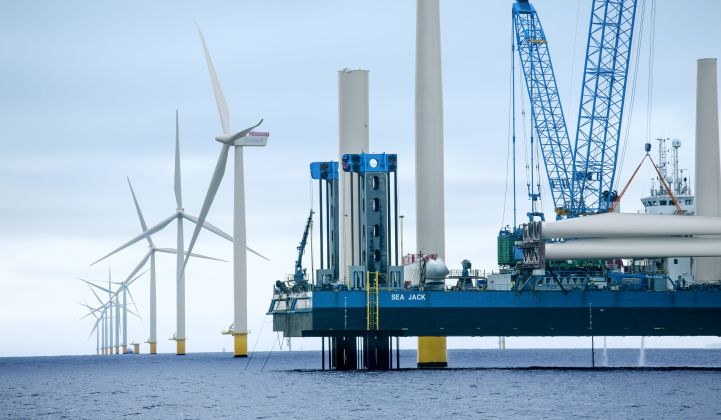Five of Ørsted’s U.S. offshore wind projects totaling nearly 3 gigawatts may face delays due to the coronavirus crisis and slowed permitting, in a blow to U.S. ambitions to animate a thriving offshore wind industry over the next few years.
Denmark’s Ørsted, the world’s top offshore wind developer, built a formidable early lead in the U.S. market, with projects stretching from New England down to Virginia, including two huge projects totaling nearly 2 gigawatts for New Jersey and New York.
On Wednesday Ørsted confirmed that two smaller projects — the 120-megawatt Skipjack for Maryland and the 130-megawatt South Fork for New York — are all but certain to be delayed beyond their planned completion dates in 2022. Ørsted now expects to finish Skipjack in the following year, and COVID-19-related shutdowns in New York “will also very likely delay South Fork beyond 2022,” the company said in a statement.
Meanwhile, Ørsted said its three largest awarded U.S. offshore projects — the 704-megawatt Revolution Wind for Rhode Island and Connecticut; 880-megawatt Sunrise Wind for New York; and 1.1-gigawatt Ocean Wind for New Jersey — face “increased risk of delays.”
“Our offshore development projects in the U.S. are moving forward, although at a slower pace than originally expected due to a combination of the Bureau of Ocean Energy Management’s (BOEM) prolonged analysis of the cumulative impacts from the build-out of U.S. offshore wind projects, and now also COVID-19 effects,” Ørsted said in a statement.
In a call with investors, Ørsted CEO Henrik Poulsen said the company does not currently see a risk to its power-purchase agreements and still hopes to finish its three largest projects on time in 2023-24.
Ørsted has already submitted to BOEM its Construction and Operations Plans (COP) for the Ocean Wind and Revolution Wind projects, but said the agency has not provided a firm timeline for approval. Offshore site survey work for New York’s Sunrise Wind project has been delayed by the COVID-19 lockdown, slowing preparation of the COP application for that project.
“We are working to the same [commercial operation date] schedule [for those projects], but we need to soon receive those permits — if not there could be a delay, not necessarily a full-year delay,” Poulsen said. “We don’t see any of the PPAs at risk; that’s not a concern for now.”
New England utility Eversource Energy owns 50 percent of the South Fork, Revolution and Sunrise Wind projects. The Ocean Wind project is being built in partnership with New Jersey utility PSEG. GE and Siemens Gamesa Renewable Energy are set to supply the five projects with turbines.
Maxwell Cohen, principal analyst for Americas Power & Renewables research at Wood Mackenzie, said more delays in the U.S. offshore wind market are not surprising.
With its name attached to nearly half of the market's awarded capacity to date, Ørsted remains in a "strong position" and able to ride out setbacks for any one particular project, Cohen said. "But...anything systemic that slows the entire offshore wind industry in the U.S. will impact them as well as other market players."
A slower liftoff than hoped?
After building substantial momentum over the past few years, the fledgling U.S. offshore wind market has seen a number of recent setbacks, starting with the unexpected permitting delay of what was supposed the country's first large-scale project, Vineyard Wind's 800-megawatt development for Massachusetts.
The developer U.S. Wind, owned by Italy's Toto Holdings, has delayed the scheduled completion date for its 248-megawatt Marwind projects from 2020 to 2023, as GTM revealed last year. Last week New York said that while it plans to procure as much as 2.5 gigawatts of additional offshore wind in its next solicitation, the procurement will not go ahead this summer due to coronavirus.
Ørsted's delays underscore the ongoing struggle offshore developers face in obtaining timely project approvals at the federal level — uncertainty that existed even before the coronavirus outbreak slowed many government processes.
Last week James Bennett, manager of BOEM’s renewable energy program, said his team is in a “full telework arrangement right now” as a result of the COVID-19 shutdown.
BOEM, which oversees the leasing of areas in federal waters for energy development, is sticking to the timeline that would see Vineyard Wind's already-delayed project get its final decision by the end of this year, but Bennett cautioned that the pandemic could impact that schedule.
“We don’t anticipate any schedule slips just yet,” Bennett said on April 21. “A lot of it will depend on how things work out with COVID and whether we’re able to have the stakeholder involvement at the level that we’d like to."
Even before COVID-19, Wood Mackenzie was not expecting any large-scale projects to reach completion before 2023, making the outbreak "more of a redundant delay than an additive delay," Cohen said.
But WoodMac's forecast "has the market ramping up to over 2 gigawatts per year immediately in 2023, which is a heavy lift for the industry, especially if the coronavirus continues to linger and impact things into next year," Cohen said.
Additional reporting contributed by John Parnell.




